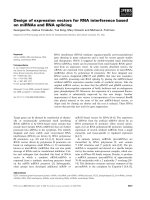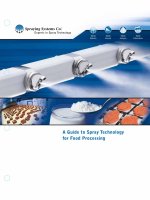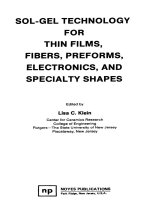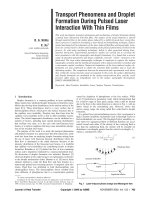SOL-GEL TECHNOLOGY FOR THIN FILMS, FIBERS, PREFORMS, ELECTRONICS, AND SPECIALTY SHAPES potx
Bạn đang xem bản rút gọn của tài liệu. Xem và tải ngay bản đầy đủ của tài liệu tại đây (21.18 MB, 424 trang )
SOL-GEL TECHNOLOGY
FOR
THIN FILMS,
FIBERS, PREFORMS,
ELECTRONICS, AND
SPECIALTY SHAPES
Edited by
Lisa C. Klein
Center for Ceramics Research
College of Engineering
Rutgers-The State University of New Jersey
Piscataway, New Jersey
I PI
n
NOYES PUBLICATIONS
Park Ridge, New Jersey, U.S.A.
Copyright @ 1998 by Noyes Publications
No part of this book may be reproduced or utilized in
any form or by any means, electronic or mechanical,
including photocopying, recording or by any informa-
tion storage and retrieval system, without permission
in writing from the Publisher.
Library of Congress Catalog Card Number: 87-34780
ISBN: 08155-1154-X
Printed in the United States
Published in the United States of America by
Noyes Publications
Mill Road, Park Ridge, New Jersey 07656
10987654
Library of Congress Cataloging-in-Publication Data
Sol-Gel technology for thin films, fibers, preforms,
electronics, and speciality shapes.
Bibliography: p.
Includes index.
1. Ceramic materials. 2. Glass fibers.
3. Thin films. 4. Colloids. I. Klein, Lisa C.
TP662.S65 1988 666.15 87-34780
ISBN 0-8155-1154-X
To my daughter, Martha Ann Kinseiia, who
was born while the book was in progress.
and
To Dennis Ravaine, my scientific collabora-
tor and friend, who passed away suddenly
in 1986.
MATERIALS SCIENCE AND PROCESS TECHNOLOGY SERIES
Editors
Rointan F. Bunshah, University of California, Los Angeles (Materials
Science and Technology)
Gary E. McGuire, Microelectronics Center of North Carolina (Elec-
tronic Materials and Processing)
DEPOSITION TECHNOLOGIES FOR FILMS AND COATINGS; Develop-
ments and Applications: by Rointan F. Bunshah et al
CHEMICAL VAPOR DEPOSITION FOR MICROELECTRONICS; Principles,
Technology, and Applications: by Arthur Sherman
SEMICONDUCTOR MATERIALS AND PROCESS TECHNOLOGY HAND-
BOOK; For Very Large Scale Integration (VLSI) and Ultra Large Scale Integration
(ULSI): edited by Gary E. McGuire
SOL-GEL TECHNOLOGY FOR THIN FILMS, FIBERS, PREFORMS, ELEC-
TRONICS, AND SPECIALTY SHAPES: edited by Lisa C. Klein
HYBRID MICROCIRCUIT TECHNOLOGY HANDBOOK; Materials, Proc-
esses, Design, Testing and Production:
by James J. Licari and Leonard R.
Enlow
HANDBOOK OF THIN FILM DEPOSITION PROCESSES AND TECH-
NIQUES; Principles, Methods,
Equipment and Applications: edited by
Klaus K. Schuegraf
Related Titles
ADHESIVES TECHNOLOGY HANDBOOK: by Arthur H. Landrock
HANDBOOK OF THERMOSET PLASTICS: edited by Sidney H. Goodman
HANDBOOK OF CONTAMINATION CONTROL IN MICROELECTRONICS;
Principles, Applications and Technology: edited by Donald L. To/liver
Contributors
Carol S. Ashley
Sandia National Laboratories
Albuquerque, New Mexico
John B. Blum
Norton Company
Northboro, Massachusetts
Jean Pierre Boilot
Groupe de Chimie du Solide
Laboratoire de Physique de la
Matiere Condensee
Ecole Polytechnique
Palaiseau, France
C. Jeffrey Brinker
Sandia National Laboratories
Albuquerque, New Mexico
Richard K. Brow
Department of Materials Science
and Engineering
The Pennsylvania State University
University Park, Pennsylvania
Lee A. Carman
Department of Materials Science
and Engineering
The Pennsylvania State University
University Park, Pennsylvania
Philippe Colomban
Groupe de Chimie du Solide
Laboratoire de Physique de la
Matiere Condensee
Ecole Polytechnique
Palaiseau, France
Helmut Dislich
Schott Glaswerke
Mainz, Federal Republic of
Germany
Raymond L. Downs
KMS Fusion, Inc.
Ann Arbor, Michigan
Matthias A. Ebner
KMS Fusion, Inc.
Ann Arbor, Michigan
Jochen Fricke
Physikalisches lnstitut der
Universitat Am Habland
Wurzburg, West Germany
Stephen H. Garofalini
Ceramics Department
Rutgers-The State University of
New Jersey
Piscataway, New Jersey
ix
x Contributors
Lisa C. Klein
Ceramics Department
Rutgers-The State University of
New Jersey
Piscataway, New Jersey
William C. LaCourse
Alfred University
Alfred. New York
Wayne J. Miller
KMS Fusion, Inc.
Ann Arbor, Michigan
Shyama P. Mukherjee
IBM Corporation
Endicott, New York
George F. Neilson
Microgravity Science and
Applications Group
Jet Propulsion Laboratory
California Institute of Technology
Pasadena, California
Richard B. Pettit
Sandia National Laboratories
Albuquerque, New Mexico
Carlo G. Pantano
Department of Materials Science
and Engineering
The Pennsylvania State University
University Park, Pennsylvania
Eliezer M. Rabinovich
AT&T Bell Laboratories
Murray Hill, New Jersey
Scott T. Reed
Sandia National Laboratories
Albuquerque, New Mexico
Sumio Sakka
Institute for Chemical Research
Kyoto University
Uji, Kyoto-Fu, Japan
Harold G. Sowman
3M
St. Paul, Minnesota
Ian M. Thomas
Lawrence Livermore National
Laboratory
University of California
Livermore, California
Michael C. Weinberg
Microgravity Science and
Applications Group
Jet Propulsion Laboratory
California Institute of Technology
Pasadena, California
Masayuki Yamane
Department of Inorganic Materials
Tokyo Institute of Technology
Tokyo, Japan
NOTICE
To the best of the Publisher’s knowledge
the information contained in this publica-
tion is accurate; however, the Publisher
assumes no liability for errors or any con-
sequences arising from the use of the in-
formation contained herein. Final deter-
mination of the suitability of any informa-
tion, procedure, or product for use con-
templated by any user, and the manner
of that use, is the sole responsibility of the
user.
Mention of trade names or commercial
products does not consititute endorsement
or recommendation for use by the Publisher.
The book is intended for informational
purposes only. The reader is warned that
caution must always be exercised when
dealing with hazardous materials, and expert
advice should be obtained at all times when
implementation is being considered.
xii
Preface
This book covers the principles, developments, techniques, and applica-
tions of sol-gel processing. The solgel process is not new, however, a few com-
mercial successes in the recent past have revived interest. The commercial
successes are largely in the area of thin films. These films have been developed
for optical, mechanical and electrical applications. About one-third of this book
covers thin films.
The second area where there has been commercial success is fibers. These
fibers whether spun or drawn may be continuous or woven. The applications
realized and projected are refractories, composite reinforcement and thermal
insulation. About one-third of this book covers fibers.
The third area encompasses the special applications such as preforms, micro-
balloons and electronics. Discussion of the chemistry, polymerization, drying
and characterization are all necessary parts of a treatment of sol-gel processing.
The anticipated product of this effort is a book that covers the background
and fundamentals. Also, it evaluates the present technology and projects new
directions short range and long range.
The graduate students at Rutgers University, P. Anderson, H. delambilly,
T. Gallo, T. Lombardi and J. Ryan, are thanked for their editorial assistance.
Visiting scientists Jean-Yves Chane-Ching and Henry Wautier served as reviewers.
Center for Ceramics Research
Rutgers-The State University of New Jersey
Piscataway, New Jersey
December 1987
Lisa C. Klein
vii
Contents
PART I
CHEMISTRY AND PHASE TRANSFORMATIONS
1. MULTICOMPONENT GLASSES FROM THE SOL-GEL PROCESS
.2
Ian M. Thomas
Historical Introduction.
.2
Preparation
.3
General
3
All-Alkoxide Method
.3
Al koxide-Salt Method
.6
Other Methods
.8
Properties
.9
Homogeneity
.9
Comparison with Conventional Glass.
10
Purity 1 0
Fabrication and Use.
11
General 1 1
Bulk Glass by Melting.
.I1
Bulk Glass Without Melting.
.12
Commercial Products.
.I2
Conclusions
.I3
References.
.I3
2. SIMULATION OF THE SOL-GEL PROCESS.
.I6
Stephen H. Garofalini
Introduction.
.I6
Computational Procedure
.I8
Results and Discussion
.23
Conclusions
.26
References.
.26
. . .
XIII
xiv Contents
3. PHASE TRANSFORMATION IN GELS: A COMPARISON OF THE
PHASE TRANSFORMATION BEHAVIOR OF GEL-DERIVED AND
ORDINARY Na*O-SiOz GLASSES. .28
Michael C. Weinberg and George F. Neilson
Introduction. .28
Metastable Liquid-Liquid Immiscibility in NazO-SiOz Glass .30
Immiscibility Temperatures. .30
Initial Study of Phase Separation of Gel-Derived Glass .32
Morphology of Phase Separation .32
Immiscibility Temperature .32
Compositional Effects .37
Factors Affecting Phase Separation Behavior .38
Trace Impurities .38
Water 3 9
Structure. .41
Phase Separation Kinetics .41
Recent Studies .43
Crystallization of Na*O-SiOz Gel and Glass .44
Summary and Conclusions .46
References. .46
PART II
COATINGS, THIN FILMS AND SURFACE TREATMENT
4. THIN FILMS FROM THE SOL-GEL PROCESS .50
Helmut Dislich
Introduction and Highlights of the Sol-Gel Process. .50
Principles of the Sol-Gel Dip Process. .51
Process Technology. .52
Process Advantages .52
Other Coating Techniques. .54
Chemistry and Physical Principles of the Sol-Gel Dip Process. .54
General Comments .54
Single Oxides .55
Mixed Oxides. .57
Cermets 5 7
Non-Oxide Layers. .58
Multi-Component Oxide Layers. .58
Organic-Inorganic Layers .60
Coated Products Based on Sol-Gel Technology .63
Rear View Mirrors for Automobiles .63
Solar Reflecting Glass (IROX) .64
Anti-Reflective Coatings. .67
Other Surface Coated Glasses. .68
Sol-Gel Layers Under Development. .68
Antireflective Coatings. .69
Contrast Enhancing Filters for Data Display Screens .69
Porous Antireflective Coatings in the UV-Range .69
Contents xv
Antireflective Coating of Silicon Solar Cells
.7O
Leaching of Multicomponent Oxide Layers
.70
Spray-Coated Diffusor Layers
.70
Transparent, Electric Conducting, IR-Reflecting Layers
.72
Indium-Tin-Oxide Layers
.72
Cadmium Stannate
.73
Opto-Electronic Films
.74
Magnetic Films.
.74
Barrier Films
.74
Sulfide Films
.74
Glassy Thick Films
.75
Unsupported Glass Films
.75
New Oxide-Based Gel Films.
.75
Organic Modified Silicate Films
.75
Scuff Resistant Layers
.75
Solid Phase System for Radio lmmuno Assay
.75
Protective Coatings
.76
Conclusions
.76
References.
.76
5. ANTIREFLECTIVE FILMS FROM THE SOL-GEL PROCESS
.BO
Richard B. Pettit, Carol S. Ashley, Scott T. Reed and
C. Jeffrey Brinker
Introduction.
.BO
Optical Properties of Thin Films.
.Bl
Sol-Gel Processing
.B4
AR Coatings.
.85
Microstructure Tailoring.
.87
Applications.
.91
AR Coatings on Silicon Solar Cells
.91
Antireflection Coatings on Glass.
-94
Full Scale Process Development
.98
Aging and Etching Conditions
.98
Adaptation to Tubular Geometries
.98
Sol-Gel AR Films on Plastics.
.99
Summary 10 2
Appendix: Optical Modeling.
103
References.
109
Appendix References.
109
6. OXYNITRIDE THIN FILMS FROMTHE SOL-GEL PROCESS.
110
Carlo G. Pantano, Richard K. Brow and Lee A. Carman
Introduction.
110
Thermochemistry in the Si-O-N-H System.
111
Film Formation
.I16
Film Composition and Structure
118
Optical Properties
.123
Electrical Properties.
127
xvi Contents
Oxidation Resistance
131
Summary.
136
References.
.I36
PART III
CONTINUOUS. DISCONTINUOUS AND WOVEN FIBERS
7. FIBERS FROM THE SOL-GEL PROCESS.
140
Sumio Sakka
introduction.
140
Variations of Sol-Gel Fiber Preparation
141
Fibers Through Low Temperature Drawing from Metal
Alkoxide Sols.
.I42
Significance of Fiber Drawing at Low Temperature
142
Conditions for Gel-Fiber Drawing.
144
Possibility of Fiber Drawing
144
Time Period Required for the Reaction Leading to
Occurrence of Spinnability
145
Shape of Fiber Cross-Section.
146
Process of Hydrolysis-Polycondensation.
146
Reduced Viscosity.
146
Intrinsic Viscosity.
147
The Nature of Linear Polymeric Particles.
150
Fibers of Compositions Other Than Silica
151
Properties of Fibers Synthesized by the Sol-Gel Process
152
Basic Properties.
152
Properties of New Glasses: Alkali-Resistance of Zirconia-
Containing Fibers
152
Appearance of Films
.I53
Mechanical Strength of Fibers
153
Fibers Formed by the Unidirectional Freezing of Gel.
154
Preparation of the Fiber.
155
Properties of Fibers Made by Unidirectional Freezing.
158
References.
.159
8. ALUMINA-BORIA-SILICA CERAMIC FIBERS FROM THE SOL-
GELPROCESS l6 2
Harold G. Sowman
Introduction.
.I62
Processing
.I63
Alz03-BzOs Frbers.
.I63
The Effect of Boric Oxide Additions.
164
Microstructure Development
165
Properties of A120s-B*Os-Si02 Fibers.
173
A1203-S~0 Frbers
.2.
173
Commercial A1203-B203-Si02 Fibers
175
Applications.
177
Ceramic Fiber-Metal Composites.
177
Contents xvii
Ceramic Fiber-Polymer Composites.
177
Flame Barriers
.I77
Ceramic-Ceramic Composites.
177
High Temperature Fabric
179
Modified Ai203-B,Oa-Si02 Fibers
179
Leached A120s-B,Os-Si02 Fibers.
179
Cermet Fibers.
180
Summary.
182
References.
.I82
9. CONTINUOUS FILAMENT FIBERS BY THE SOL-GEL PROCESS.
.184
William C. LaCourse
Introduction.
.I84
Sol Structure
.I84
Sol Requirements for Continuous Filament Formation.
184
Initial Sol Structure.
185
Summary-Sol Structure
188
Processes for Silica Fiber.
188
Mixing
188
Prereaction 18 8
Sol Aging.
189
Drawing 19 0
Silica Fiber Properties
191
As Drawn Fibers.
191
Consolidated Fibers.
192
TiOz, ZrOz, and Binary Oxide Fibers
194
Closing Comments.
196
References.
.I97
PART IV
MONOLITHS, SHAPES AND PREFORMS
10. MONOLITH FORMATION FROM THE SOL-GEL PROCESS.
.200
Mass yuki Yamane
Introduction.
.200
Gel Preparation.
.201
Types of Gels Used for Monolith Formation.
.201
Gel Formation from Silicon Alkoxide
.201
Composition of Precursor Solution.
.201
Effect of Catalyst
.203
Effect of Temperature
203
Drying 20 4
Gel Properties.
.205
Pore Size Distribution and Specific Surface Area.
205
Hydroxyl Groups and Residual Organic Compounds
.209
Change in Structure and Properties of a Gel with Heat Treatment. . 211
Differential Thermal Analysis and Thermogravimetric
Analysis.
.211
xviii Contents
Change in Density and Linear Shrinkage
.213
True Density
.213
Bulk Density
.214
Linear Shrinkage.
.215
IR and Raman Spectra.
.215
Change in Pore Size Distribution
.217
Change with Linear Heating Rate.
.217
Change Under Isothermal Treatment.
.219
Heat Cycle for the Densification of an Alkoxy-Derived
Monolithic Gel
.221
References.
.222
11. THERMAL INSULATION MATERIALS FROM THE SOL-GEL
PROCESS
22 6
Jochen Fricke
Introduction.
.226
Thermal Transport in Evacuated Porous Superinsulations
230
Radiative Transport.
.230
Solid Thermal Conduction
.233
Thermal Transport in Aerogel Tiles.
.234
General Considerations.
234
Calorimetric Measurements.
237
Effects of Gas Pressure.
.239
Thermal Transport in Granular Aerogel
241
General Aspects
.241
Calorimetric Measurements
242
Effects of Gas Pressure.
.243
Optical Transparency.
.244
Conclusions and Outlook
.245
References.
.245
12. ULTRAPURE GLASSES FROM SOL-GEL PROCESSES.
.247
Shyama P. Mukherjee
Introduction.
.247
Methods of Making Ultrapure Glasses
248
Sol-Gel Processes.
.249
Glasses from Colloids.
.249
Glasses from Gels Prepared by the Hydrolytic Polyconden-
sation of Metal Alkoxides/Metal Organics.
249
Selection of Starting Metal Alkoxides
250
Synthesis of Homogeneous Gels/Gel-Monoliths.
.252
Drying of Gel-Monoliths/Gel-Powders
253
Removal of Residual Organics and Hydroxyl Groups
253
Approach 1
.254
Approach 2
.254
Conversion of Gel to Glass
.255
Gel Processing in a Clean Room Facility
.255
Conclusion.
.256
Contents xix
References. . . . . . . . . . . . . . . . . . . . . . . . . . . . . . . . . . . . . .258
13. PARTICULATE SILICA GELS AND GLASSES FROM THE SOL-
GEL PROCESS.
.260
Eliezer M. Rabin0 vich
Introduction.
.260
Sources of Silica Powders and Particles
262
Gels from Alkali Silicates
.264
Glasses from High-Surface Area Particulate Gels
266
Fumed Silica Gels
.266
Dispersion
.266
Gelation
.266
Drying and Double Processing
.268
Combined Aikoxide-Particulate Method.
274
Sintering of Gel to Glass.
276
Elimination of Bubble Formation on Reheating of Gel
Glasses.
.280
General Scheme of the Process; Properties of Glasses
283
Glasses from Low Surface Area Powders
283
Doping Particulate Gel Glasses.
287
Applications of Particulate Gel Glasses
290
Summary.
.291
References.
.292
PART V
SPECIAL APPLICATIONS
14. ELECTRONIC CERAMICS MADE BY THE SOL-GEL PROCESS .296
John B. Blum
Introduction. .296
Advantages and Disadvantages .297
Potential Uses in Electronic Applications. 298
Piezoelectrics .298
Sensors .299
Microelectronic Packaging. 300
Magnetics. .301
Ferroelectrics. .301
Summary. .301
References. .302
15. SUPERIONIC CONDUCTORS FROM THE SOL-GEL PROCESS. .303
Jean Pierre Boilo t and Philippe Colomban
Introduction: Fast Ion Conduction .303
New Amorphous Superionic Conductors .305
Transition Metal Oxide Gels 305
Sodium Lithium Superionic Gels and Glasses 306
Optically Clear Monolithic Gels 306
Homogeneity and Densification of Gels. .309
xx Contents
Low Alkaline Compositions.
309
High Alkaline Compositions
309
Crystallization
.311
Ionic Mobility and Conductivity.
311
Lithium Salt Containing ORMOSI LS Gels
.314
Sol-Gel Routes Leading to Ceramics and Thick Films.
314
Pure Phase Powders and Ceramics.
.318
Low Temperature Sintering and Fine Grained Microstructure . . 320
How to Choose the Sintering Temperature and Overcome
the Powder Reactivity
.322
How to Choose the State of Ordering
.322
Conclusion.
,327
References.
.327
16. HOLLOW GLASS MICROSPHERES BY SOL-GEL TECHNOLOGY.
.330
Raymond L. Downs, Matthias A. Ebner and Wayne J. Miller
Introduction.
.33O
Glass Shell Uses.
.331
Review of Glass Shell Production Methods.
.331
Liquid Feed Materials.
333
Powder Feed Materials.
.333
Glass Shell Production for ICF Targets
333
Specifications of Glass Shells for ICF Targets
334
Glass Shell Starting Materials.
335
Inorganic Gels.
.337
Metal-Organic-Derived Gels
.337
All-Alkoxide Gel,
.338
Salt Gel.
.339
Parameters Affecting Shell Properties
339
Compositions of Glasses from Gels
339
Silicates.
.340
Germanates
.341
Other Oxides
.341
Gel Processing and Shell Blowing Procedures
341
Alcogel Drying
.342
Comminution and Sizing.
.342
Supplementary Treatment.
.342
Gel-to-Glass Transformation
343
Reduction of Organic Content in Metal-Organic Xerogels: Gel
Characterization
343
Water Vapor Hydrolysis of Xerogel.
344
Pyrolysis of Xerogel.
.348
Gas Evolution.
.348
Specific Heat
.350
Gel Morphology
.352
Experimental Parameters that Influence Shell Properties.
353
Drying of the Alcogel.
.353
Hydrolysis and Pyrolysis of Xerogels.
353
Contents xxi
Shell Processing Parameters.
.357
Furnace Parameters.
.357
Furnace Length.
.357
Furnace Temperature.
357
Gel Addition Parameters.
359
Furnace Gas Parameters
.362
Models
36 4
Physical Transformation from Gel to Shell.
.364
Empirical Predictive Model for Shell Production
.369
Screening Experiments.
.372
Response Surface Experiments.
.372
Compositional Experiments.
377
References.
.379
17. FILTERS AND MEMBRANES BY THE SOL-GEL PROCESS.
.382
Lisa C. Klein
Introduction to Filtration.
382
Fluid Flow Equations.
.383
Processing Ceramic Membranes
384
Chemical Leaching Approach.
.384
Sintering Approach
384
Sol-Gel Approach
.385
Silica.
.385
Alumina
.385
Characterizing Porosity.
386
Definitions.
.386
Nitrogen Sorption Analysis.
.387
Texture of Microporous Silica
.388
Texture of Microporous Alumina
389
Preparation of Micro/Macroporous Silica Sheets
392
Experimental Techniques
.393
Results
.393
Discussion
.397
Summary.
.397
References.
.398
INDEX 400
Part I
Chemistry and Phase
Transformations
Multicomponent Glasses from the
Sol-Gel Process
Ian M. Thomas
Lawrence Livermore National Laboratory
University of California
L ivermore, California
HISTORICAL INTRODUCTION
The preparation of multicomponent glasses by the sol-gel process dates from
1950; at that time Della and Rustum Roy’ prepared a number of compositions
from silicon tetraethoxide and metal nitrate salts primarily for phase equilibrium
studies where homogeneous samples are essential. This new method gave products
which, when melted just once, gave a glass more homogeneous than the best
glasses obtained after three successive melting and crushing operations of sam-
ples prepared in the conventional manner from individual oxides. Hamilton and
Mackenzie in 1960,’ Luth and lngamells in 1965,3 Hamilton and Henderson in
19684 and Biggar and O’Hara in 1969’ all described variations of the same pro-
cess primarily directed towards the preparation of silicate mixtures for phase
equilibrium studies.
An investigation of bulk glass systems by the sol-gel process was started at
Owens-Illinois, Inc. in 1967 by Levene and Thomas.6 This work resulted in the
commercialization of several four component sputtering glass target discs in
1969 and six component planar dopant discs a few years later. The process in-
volved a combination of metal alkoxides and metal acetates as oxide sources and
was used because of the high purity requirements not specifically for homoge-
neity. Dried gel products were melted and fabricated by conventional means.
Sol-gel coating systems were extensively studied at Schott Glass starting in
the 1950’s. Although the initial emphasis appeared to have been on the prepara-
tion of single oxide optical coatings, mainly Ti02 and SiOz, mixed oxide ma-
terials were also investigated and this led to commercial products. The work is
2
Multicomponent Glasses from the Sol-Gel Process 3
described by Schroeder first in 19627 and in more detail in 1969;8 a summary is
also given by Dislich.’ Later both Schroeder and Dislich investigated bulk gel
preparation by an all alkoxide route described by Dislich in 1971 lo and resulting
in a number of patents.““’
The increasing interest of many investigators in the sol-gel process became
apparent in the mid-1970’s and the amount of published work has blossomed
since that time. In the following sections various aspects of multicomponent glass
preparation, properties and uses will be described. The review is restricted to
multicomponent glass systems and so the emphasis will naturally be on silicate
materials. It is of note, however, that a lot of work has been reported on silica
alone and on both single oxide and multicomponent oxide ceramic systems. The
ceramic systems have shown some impressive advantages, especially with respect
to processing, over their conventional equivalents.
PREPARATION
General
The prime objective in all preparations of multicomponent oxide composi-
tions is to obtain initially a solution of all components in the form of soluble
precursor compounds; mixing can then be considered to be at the molecular
level and if this level can be retained in the subsequent conversion to oxides a
very homogeneous product should result. In most cases it does appear that oxide
products prepared in this manner at low temperature are indistinguishable from
those obtained in the conventional manner by fusing the relevant oxide mixtures
at high temperature. This will be discussed in more detail later.
There are a number of different types of precursor materials that can be
used. All should be soluble in organic solvents and easily converted to the rele-
vant oxide preferably by hydrolysis but alternatively by chemical reaction or
thermal or oxidative decomposition. Several preparative methods are available
dependent on the nature of the starting materials and these are described below.
All-Alkoxide Method
Probably the best starting materials for solgel preparations are the class of
materials known as metal alkoxides. All metals form alkoxides and they have the
following general formula:
M(OR)x
where M is the metal, R is an alkyl group, and x is the valence state of the metal.
All metal alkoxides, with two notable exceptions, are rapidly hydrolyzed to
the corresponding hydroxide or oxide. The method of hydrolysis can be varied
and many times depends on the final use of the product. This will become ap-
parent later but the overall reaction can be represented as follows:
MCOR), + xH20 - M(OH)x + xROH
2M(OHjx - M20x + xH20
4 Sol-Gel Technology
The by-product, ROH, is an aliphatic alcohol and readily removed by vola-
til ization.
The two notable exceptions are the alkoxides of silicon and phosphorus.
Silicon alkoxides require an acid or basic catalyst for hydrolysis and even with
these the reaction rate is slow. Trialkylphosphates are very difficult to hydrolyze
and this precludes their use as a source of phosphorus in sol-gel preparations.
There is also a limited class of compounds known as double alkoxides. These
contain two different metals in the same compound and have the general formula:
M’M” (OR)
XY
z
where M’ and M” are metals, R is an alkyl group and x, y and z are integers.
The physical properties of metal alkoxides can be varied by changing the
alkyl group and for most metals soluble, and in some cases even liquid, products
can be obtained. In addition, many alkoxides are volatile and can readily be puri-
fied by distillation; this can lead to very pure oxide products. Double alkoxides
have the added advantage of not only being volatile but retaining exact molecu-
lar stoichiometry between the metals. An excellent source of information on
metal alkoxides is the book by Bradley et all3 which is highly recommended
reading for anyone starting in the sol-gel field.
The simplest method of preparation of multicomponent systems involves
making a solution of all the components as alkoxide precursors in a suitable or-
ganic solvent and then reacting the solution with water to form the oxide mix.
The reaction can be represented for a three component system as follows:
NOR), + M’(OR+, + WOR), + xHZO - MO,,* + M’Ot,,2 + M”O,,g t yROH
This was the method first used by Schroeder” and Dislich” and has since
been used by many other investigators. The reaction is far more complex than
the simple hydrolysis shown in the equation above. It involves first hydrolysis
of metal alkoxide groups to metal hydroxide groups and subsequent condensa-
tion of these groups with each other or with unhydrolyzed alkoxide groups to
give products containing M-O-M linkages (metallometalloxane polymers).
M-OR t HZ0 -
M-OH t ROH.
M-OR +
M-OH -
M-O-M
t ROH.
M-OH +
M-OH -
M-O-M
t HZ0
The products can contain one or more metal atoms in the same molecule depend-
ing on the relative hydrolysis and condensation reaction rates of the component
metal alkoxides. The more alkoxides present in the original mixture the more
complex can the polymerization become. Ultimately, the polymeric products
become insoluble due to cross-linking and gellation or precipitation results. The
complexity of a multicomponent system makes investigation of the reaction
mechanisms extremely difficult. Brinker and Scherer14 give an excellent sum-
mary of research in this field and describe their own extensive investigations on
polymer growth and gel formation.
Multicomponent Glasses from the Sol-Gel Process 5
The variation in reaction rates especially in the initial hydrolysis can give
rise to inhomogeneities in the final product. This is particularly the case for
those materials containing silicon which of course includes all silicate glasses.
When hydrolysis is rapid, as is the case with the addition of an excess of liquid
water, the hydrolysis rate of silicon alkoxides is so slow that they can remain
substantially unreacted when all other components in the mixture have already
precipitated as oxides. Gross inhomogeneities then result.
One way of avoiding this problem is to carry out the hydrolysis very slowly.
The alkoxide mixture can be made up in a suitable solvent then exposed in bulk
to atmospheric moisture, or wet alcohol, sometimes containing acidic or basic
catalysts, can be slowly added. In both cases, soluble polymerized products are
initially formed and this is followed by a viscosity increase and eventual gelation;
this process combined with concurrent solvent evaporation can take from days to
weeks. The exact method of hydrolysis depends on the final use of the product;
at the viscous, but still soluble, stage fibers have been spun from certain compo-
sitions; monolithic dried gels have been obtained when the process is taken to
the gel stage. Both of these topics are covered in much greater detail in other
sections of this book.
Another method for avoiding the variable hydrolysis rate problem was de-
vised by Levene and Thomas6 in 1972. This involved a partial hydrolysis of the
silicon alkoxide (usually the ethoxide) with an equimolar quantity of water
using an acid catalyst to give a trialkoxysilanol which remained in solution:
CR014Si + HRO - (ROQSIOH + ROH.
The addition of other alkoxides then followed and this resulted in reaction
between them and the silanol derivative to form soluble metallosiloxane deriva-
tives:
(RO)SSiOH + MCOR’), - (R0)3Si-O-M(OR’),, + R’OH.
This reaction is well known and has been used in the preparation of many
siloxy-metal monomers” and polymers16 in non sol-gel applications, e.g.:
Ti(OCSH714 + 4KHS)SSiOH
- TiCOSiKH3)314 + 4CSH70H.
All metal alkoxides so far investigated react with silanol derivatives to give
metallosiloxane products, so all alkoxides subsequently added to the partially
hydrolyzed silicate mixture will react provided that there are sufficient silanol
groups available for reaction. This is usually no problem in silicate glass compo-
sitions which normally contain a major portion of silica. While the formation of
these metallosiloxanes is a complex reaction, especially if more than one addi-
tional alkoxide is added, it was found that these derivatives were susceptible to
further hydrolysis and can be considered to be similar to single alkoxides except
that they contain two or more metals in the same compound. Addition of more
water ultimately gave homogeneous oxide products.
A similar method for titanium silicate systems was later used by Yoldas17 in
6 Sol-Gel Technology
which he prehydrolyzed a titanium alkoxide and then reacted this with silicon
tetraethoxide monomer to give a soluble titanosiloxane polymer:
Ti(ORj4 + Hz0 - (R0j3TiOH + ROH.
(R0)3TiOH + S1W2HS)4 - (R0)3Ti-O-SiGC2HS)3 + C2H50H.
Further hydrolysis of the product ultimately gave a homogeneous oxide
mixture.
It is fairly obvious that this method can be extended to cover the use of any
metal alkoxide that can give soluble partially hydrolyzed materials containing re-
active hydroxyl groups. The latter can then be reacted with the silicate to form a
metallosiloxane polymer.
AlkoxideSalt Method
For some metals it is inconvenient to use alkoxides because of preparation
problems or unavailability and alternative starting materials must be found. This
is particularly the case with Group I and Group II elements whose alkoxides
are solid, non-volatile and in many cases of low solubility; consequently, they
are sometimes difficult to obtain pure. Metal salts provide a viable alternative
provided that they are readily converted to the oxide by thermal or oxidative
decomposition and are preferably soluble in organic solvents. They also usually
can be obtained as a high purity analytical grade. Salts of organic acids, in par-
ticular acetates but also formates, citrates, tartrates, etc. are potential candidates.
Nitrates are really the only suitable inorganic salts because others, such as chlo-
rides or sulfates, are more thermally stable and the anion may be difficult to
remove.
The normal method of solgel preparation using salts is first to form a SOIU-
tion of all components which are to be added as alkoxides, as described in the
preceding section, and then add one or more salts as solutions in alcohol or, if
this is not possible, in the water that is to be used for further hydrolysis. All
components are then uniformly dispersed and subsequent gelation should then
freeze all elements in a gel network.
The first sol-gel preparations carried out by the Rays” used silicon tetra-
ethoxide and solutions of the nitrates of Group I and Group II elements as well
as those of aluminum, lead, iron, lanthanum, titanium, zirconium, thorium,
nickel and gallium. A major drawback to the preparation of ultrahomogeneous
glass using nitrates was pointed out by Roy and McCarthy” and this was the
tendency for one or more nitrates to crystallize during dehydration thereby
destroying homogeneity; this effect was especially bad with sodium, lead and
barium nitrates. The solution to the problem was to evaporate a large portion of
the water before the solution gelled which was possible if the pH was kept low.
A word of’warning should be given on the use of nitrates in preparations
involving more than a few hundred grams of material. Nitrates are strong oxi-
dizing agents and there are initially large quantities of oxidizable material present
in the system, this can lead to uncontrollable exotherms and even explosions
during drying.
Multicomponent Glasses from the Sol-Gel Process
7
The use of acetate salts was first described by Levene and Thomas’s and these
were used in much the same way as nitrates. In some cases acetates are more
soluble than the corresponding nitrates for example, those of sodium, potassium
and barium, and their use therefore reduces the crystallization tendency described
above. Also the explosion hazard is eliminated in large scale preparations. Dis-
advantages are that they do not thermally degrade as cleanly as nitrates and can
be a source of carbonaceous residues; also solutions of many acetates are basic
and therefore their use leads to rapid gelation in silicate systems due to the high
pH but this can be partly negated by buffering with acetic acid.
Thomas” has found that the use of sodium acid tartrate as a sodium source
in silicate systems led to stable solutions especially useful for coating applica-
tions where gelation must be avoided. This salt is acid and also contains alcohol
groups which are potential reactants for alkoxides in the system. No doubt other
acid tartrates could be used in like manner.
Nitrates and acetates continue to be the most commonly used salts in prepa-
rations described in the recent literature, their use, however, is much less frequent
than the all alkoxide method. Some recent examples are Brinker and Mukherjef?
who used sodium and barium acetates with aluminum, boron and silicon alkox-
ides; Holand, Plumat and Duvigneaud” used magnesium acetate with aluminum
and silicon alkoxides; Phalippou, Prassas and Zarzycki23 prepared lithium alu-
minosilicates from lithium and aluminum nitrates and ethyl silicate; and some
calcium silicates were prepared from calcium nitrate and ethyl silicate by Hayashi
and Saito.24
Sol-gel preparations involving salts are usually more complex than those
with only alkoxides because the hydrolysis of the latter is more readily accom-
plished than the thermal or oxidative degradation required for the former. A
novel use of certain acetates was developed by Thomas” mainly to reduce the
amount of acetate groups that had to be removed by thermal degradation during
oxide conversion. It was found that certain acetates react with some alkoxides
to form metallometalloxane derivatives with the liberation of alkyl acetate, the
first step in the reaction is as follows:
M(OR), + M’(OAc),, - (RO),_, M-0-M’(OAc),,_, + ROAc
where AC represents the group -COCHs.
The reaction then continues with further reaction of acetate and alkoxide
groups to increase molecular weight. The reaction is carried out by heating the
reagents together in the absence of solvent and in most cases about 60-80% of
the theoretical ester can be distilled out. It is preferable for the mol ratio of
alkoxide to acetate to be greater than one and this leads to a soluble and hy-
drolyzable product that can subsequently be used in sol-gel preparations in a
similar manner to a double alkoxide.
Some acetate-alkoxide pairs that can be reacted in this manner are as fol-
lows:
Calcium acetate-aluminum alkoxide
Magnesium acetate-aluminum alkoxide
Zinc acetate-aluminum alkoxide
8 Sol-Gel Technology
Lead acetate-silicon alkoxide
Lead acetate-titanium alkoxide
Thomas” prepared CaO-MgO-AlsOa-Si02 and PbO-B203-SiOz glass com-
positions using this method and the reaction was also used by Gurkovich and
Blum*’ to prepare monolithic lead titanate.
The acetate-alkoxide reaction is particularly useful for lead silicate contain-
ing compositions because lead acetate is particularly prone to leaving carbon-
aceous residues in the oxide product.
Other Methods
As an alternative to alkoxides or salts there are a few other materials that
can be used for certain specific elements. Some metal oxides and hydroxides are
soluble in alcohols because of reaction to form partial alkoxides; these solutions
can then be used in solgel preparations in the same manner as alkoxides. The re-
actions with alcohols are reversible and solubility can sometimes be increased if
the water is removed:
MOx + 2nROH
~MOx_n(OR)2n + nH20
M(OH)x + nROH-
rMM(OH)x_n (OR),, + n/2H20
Ultimately, of course, the fully substituted alkoxide will be formed when all
the water is removed.
Examples of compounds that can be used in this manner are the oxides and
hydroxides of all Group I metals, boricacid and oxide, phosphoric acid and oxide,
lead monoxide and vanadium pentoxide. Perhaps the most commonly used ma-
terial is boric acid which can be obtained in a high state of purity and is quite
soluble in methanol (10%) because of partial alkoxide formation. Many workers
have incorporated boron into sol-gel preparations in this manner though it is dif-
ficult to avoid loss of boron from the system during the drying process because
of the high volatility of trimethylborate. It is better to dissolve the acid in a
higher alcohol and remove the water if necessary to increase solubility. Dislich26
reports that even using ethanol with boric acid there is considerable boron loss
because of the volatility of triethylborate.
Phosphoric acid is the only good source of phosphorus as the phosphorus
alkoxides are precluded because of stability; it reacts readily with silicon alkox-
ides in particular to give useful phosphorosiloxane intermediates.*’
In cases where suitable oxide precursors are not available preparations can
be carried out in which all components except one are made up in solution by
any of the standard methods and the odd one then added as a solid oxide. The
particle size of the latter oxide should be as small as possible and mixing then
carried out vigorously enough to coat each particle with the solution of the other
components. While the homogeneity is obviously not as good as a true sol-gel
material it can be considerably better than a conventional oxide mix. Thomas*’
prepared lead and zinc aluminoborosilicates and borosilicates by suspending the
relevant lead or zinc oxide in a solution of the other components then gelling
and drying in the normal manner. It was then possible to obtain these low melt-









